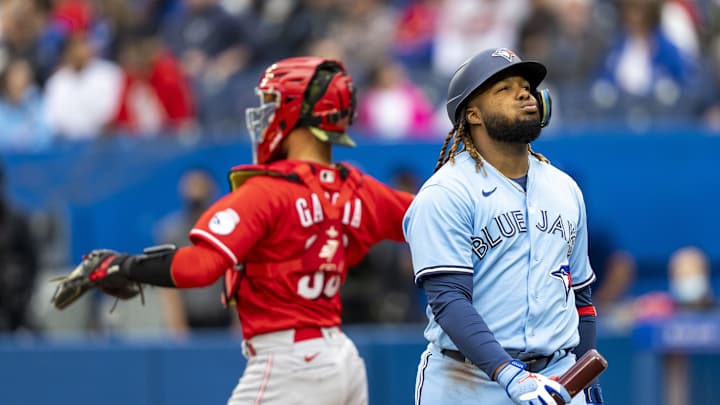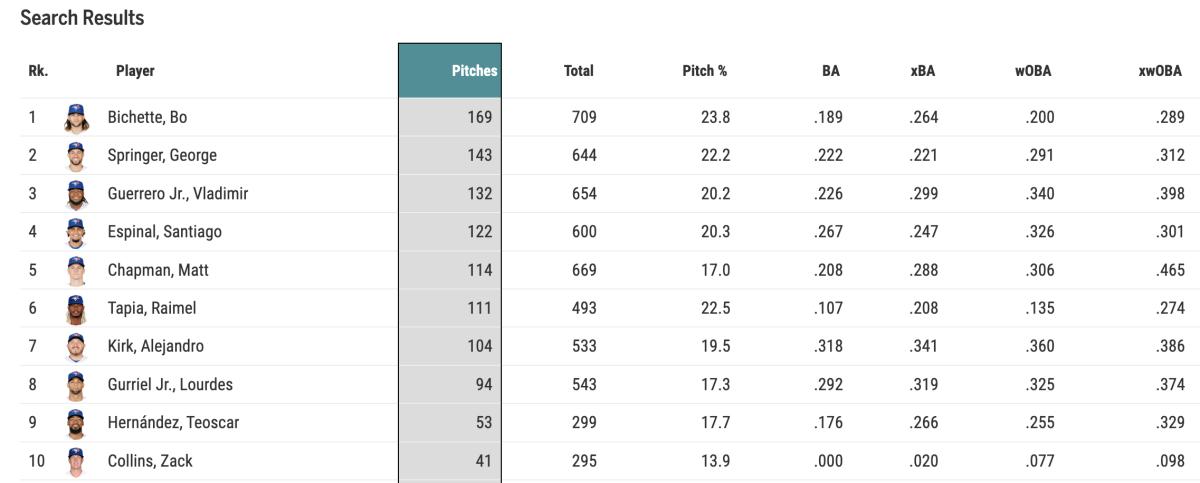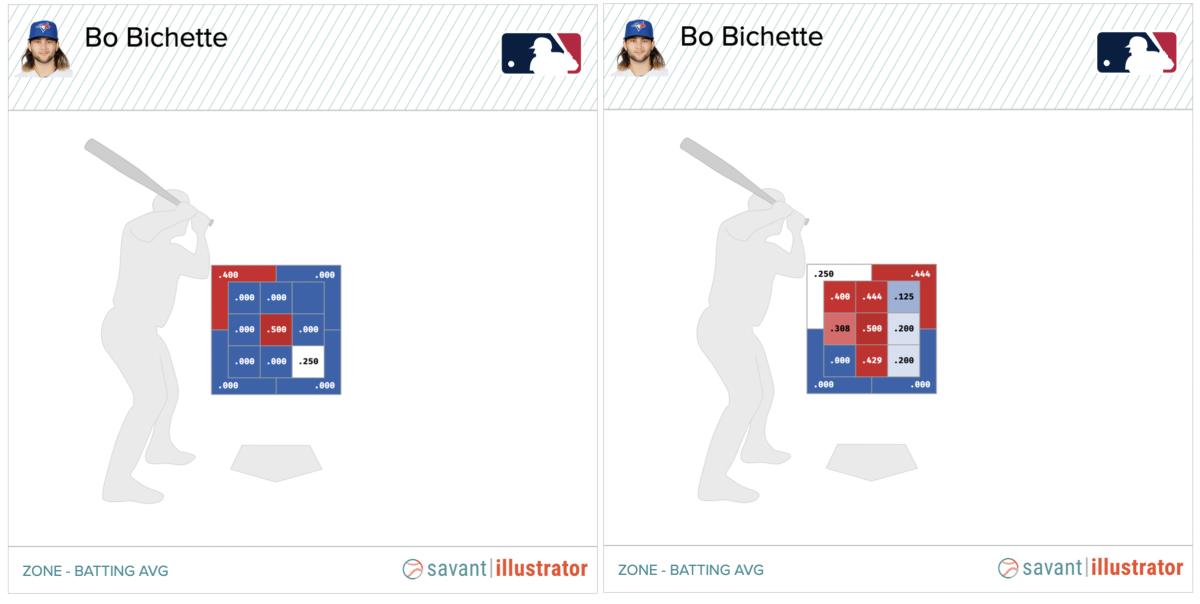Are Blue Jays Hitters Victims Of Velocity?

In 2008, the Blue Jays faced two pitches clocked over 100 miles per hour. In 43 games this year, they've seen 100+ 53 times.
You can't hide from velocity in baseball these days, it finds you. So far this season, the heat has hunted Toronto down. This week the Jays have or will face four starters with fastballs sitting in the high-90s and touching 100, moving from Hunter Greene to Jordan Hicks to Shohei Ohtani on Thursday.
The Blue Jays' offensive struggles aren't summarized with a singular stat or solved with one tweak, but the velocity they've seen, and more importantly, what they haven't done with it, is certainly a factor in the hitting woes. More than most, the heat has done Toronto in this season, but things may soon change.
“Some of it has been the pitching that we’ve faced for sure," Blue Jays GM Ross Atkins on his team's hitting troubles. "I mean, we’ve seen more velocity than most and we’re seeing a lot of it every night.”
The Blue Jays vs Velocity
The Jays have faced more velocity than any other team in baseball. They’ve seen 100 more pitches over 95 MPH than any other franchise and 19.5% of deliveries against Toronto have surpassed that mark.
Compounding the issue, the Jays have hit .207 as a team against that 95+ stuff, the fifth-worst mark in MLB. In May, more than 20% of the pitches the Blue Jays faced have come in over 95 MPH and they're hitting .176 against the heat.

13 pitchers across the league have thrown 275 or more pitches 95+ MPH this season, and the Blue Jays have faced six of them. Seattle's hard-throwing Logan Gilbert matched his season-high in strikeouts in Toronto last week, Luis Severino had his best start of the season against the Jays, and Nathan Eovaldi let up just three solo shots across two starts (11.2 IP) vs Toronto this year. Toronto's success against high-velocity hurler Jordan Hicks in St. Louis was an exception for their 2022 trend.
Who Is It Hurting?
Toronto's offensive struggles come from multiple places—swing decisions, batted ball luck, missed meatballs—but the struggles against the velo have plagued a few of the lineup mainstays in particular.
No player in baseball has faced more velocity than Bo Bichette, with 169 pitches at 95+ MPH against and seven more than the next guy. Opposing pitchers feasted on Bichette's tweaked timing in the early weeks, but with the shortstop finding his swing lately (.813 OPS in May), they're backing off the fastball. In the last two weeks, the percentage of pitches over 95 MPH Bichette is seeing has dropped 4.1% and his batting average against those pitches is up from .174 to .214.
From a production standpoint, Toronto's biggest velocity victim has been Raimel Tapia. Facing 22.5% of pitches over 95 MPH, Tapia is hitting .107 against the heat with a .135 wOBA through 111 pitches. While Tapia has actually been strong against the soft stuff, hitting .260 with a .277 xBA against pitches under 95, opposing pitchers with high velo aren't forced to show him the off-speed when he's outmatched by the fastball.
Against Seattle's Gilbert, Tapia took a first-pitch fastball high to work ahead in the count with the bases loaded. On his second pitch, Tapia was swinging, hacking through a 96 MPH heater on the outside corner. The next pitch was the same spot with the same result. The next pitch? Same spot, same result. Gilbert finished him off with 99 MPH on the outside corner, an objectively difficult pitch to hit, but one Tapia saw three times in a row before leaving the box shaking his head.

Will The Trend Continue?
While the Jays have already faced half of baseball's hardest-throwing starters this year, they aren't due for some stretch of soft tossers. With Gerrit Cole, Shane McClanahan, Severino, and Eovaldi all in the AL East, the Jays will stay on their diet of heat for the rest of the season. Toronto also matches up with the NL Central this year, which contains four of the 16 hardest throwing starters, and face the White Sox next week with Dylan Cease and Michael Kopech. If the Jays are going to cure their velocity funk, it'll come from their own bats.
Fortunately for fans of Blue Jays offense, Toronto has proven they can hit these high-velo pitches. Bichette and Vladimir Guerrero Jr. saw the most velocity on the team last year and hit .287 and .397 collectively against those 95+ deliveries. On high fastballs pitched over 95 MPH+, the Jays have a team wOBA of .157 right now (second-worst in MLB), while last year that mark was .241. (seventh-best).
This isn't the oft-mentioned oversimplification of opposing pitchers 'figuring out how to pitch to guys', that many cite for young hitters' struggles. For Toronto's top-of-the-lineup, it's missing pitches they've proven before they can hit.
We've already seen a turnaround from Bichette this year, who was one of Toronto's best hitters against hard fastballs in the zone last season (see chart below), and there are some other positive signs. In the last two weeks, Matt Chapman is hitting .273 against 95+ with George Springer hitting .300 and Lourdes Gurriel Jr. at .400. While Guerrero Jr. and Teoscar Hernández are working through undeniable funks, the Jays haven't just collectively forgotten how to hit velocity.

The expected statistics also show some batted-ball luck against hitters that should turn, too. More than half of Toronto's starting lineup is hitting 20 points or more below their expected batting average against high velocity. As a team, they're hitting almost 50 points below their xBA vs 95+ MPH stuff and have a team wOBA over 60 points lower than the expected mark. Both discrepancies are the highest in baseball.
Much like most of Toronto's offensive issues, the hope for a correction comes from the track record of success, improved execution, and a bit of luck bouncing their way. These are pitches the Jays ate up last year, and they'll have plenty more opportunity to feast on them in 2022, starting Thursday against Ohtani.
